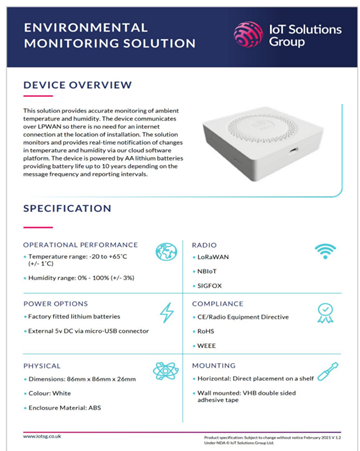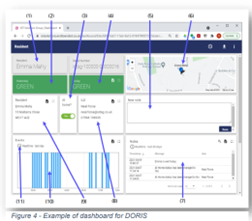This project was part of the NHS Future Wireless Trials programme and aimed to investigate the potential and impact of IoT devices to support health and wellness for occupants of high-rise tower blocks.
This case study covers a partnership programme funded by the NHS and with regional NHS participation as well as innovative commercial providers. Within the Black Country area of the West Midlands three council-run high-rise tower blocks were selected and a subset of occupants were offered IoT-enabled humidity monitors to support management of their own health and wellness. The programme evaluated both the efficacy of the connectivity and the value of the provided solutions in delivering personalised, out of clinic care.

Partners and their roles in the project:
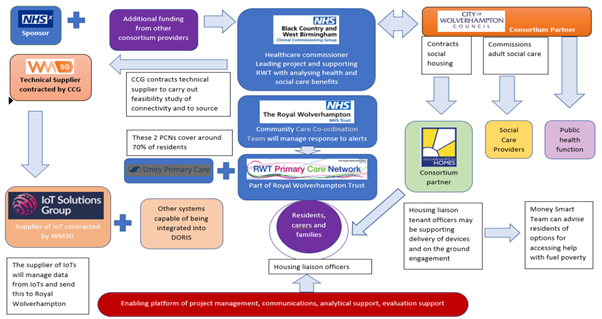
What is the problem to be solved?
As is widely known the NHS is increasingly under pressure and a range of initiatives – notably virtual wards – are underway to help people manage their health at home, relieving pressure on hospitals. The desire is to prevent unnecessary hospital admission, or readmission after discharge, by providing support in the home.
Regional NHS services aim to mobilise the local resources of the NHS to deliver better health outcomes for local people. This requires a population health approach to understand the health and social care needs to be able to deliver the most appropriate services to meet these needs. The vision is for a healthier place with healthier people and healthier futures. In the Black Country, a strategic priority is to eliminate health inequalities within communities. Some very specific challenges exist in this particular region including:
• Lower Life expectancy in areas with higher levels of deprivation - this is 7.8 years lower for men and 6.3 years lower for women in the most deprived areas of Wolverhampton than in the least deprived areas
• Lower Healthy life expectancy - in Wolverhampton this is predicted to be of 63.1 years for men living in the Merry Hill flats postcode and 64.6 years for women. This varies by between 12 and 14 years between areas in Wolverhampton
• Uneven use of emergency healthcare services - across England, there are more than twice as many
Emergency Department attendances from people living in the 10% most deprived areas. Within Wolverhampton, there are higher levels of emergency admissions resulting from alcohol-related harm than in other areas of England.
Anything that can help alleviate these inequalities whilst reducing pressures on hospitals is seen as a valuable addition.
The pilot region here – Black Country – is one of the most deprived in the UK:
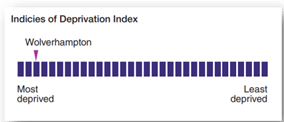
What is the solution to the problem?
Internet of things (IoTs) devices are considered most suitable for delivering low powered connectivity benefits within environments such as a residential tower block. They are wireless, battery-powered units that can submit data to a central dashboard via the low-powered connectivity.
Commercial model (Business Case)
The business case is built around the savings from reduced hospitalisation and the costs that incurs.
Capex and Opex costs for introducing the type of service covered here are low. Typically devices aren’t purchased but rather are paid for on a monthly charged managed data service basis with the provider replacing any faulty units. Some of the costings associates with the trial solution are itemised in the tables below:
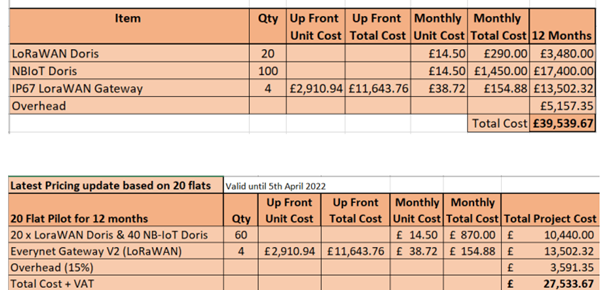
There is a vast range of possible measures that can monitored and each with a potential for health impacts. Essentially, costs for an implementation fall into three component areas:
- Running the implementation project end-to-end, including planning, project management, design, build, test, delivery, business change and training. These are specific to the project size and scope but for this trial these cumulative costs amounted to around £150k.
- Solution up-front costs. Depending on the supplier and commercial model adopted, parts of the solution, such as gateways or sensors maybe paid for in advance or on a lease basis. Gateways would be required if public or private networks are not available to connect to at the relevant locations. For this project covering 50 dwellings including x2 temperature and humidity sensors for each dwelling, the upfront costs were £12k
Solution run and maintain costs. The solution hardware could also be leased or purchased on a subscription basis, probably requires an ongoing maintenance & support package and may require chargeable connectivity depending on the network availability. For this trial, the lease costs, support and maintenance and connectivity costs amounted to c£23k per annum (£4k for x20 LoraWAN sensors & gateway; £19k for x100 NB-IoT sensors).
Image
Benefits
The primary benefits from this initiative arise for:
- patients and their carers
- the healthcare system
Patients recognise that humidity and temperature monitoring, fed-back to care teams, enable rapid identification of changes and potential issues. It provides comfort that response is on-hand when needed, potentially even when they themselves are unable to seek assistance or trigger an alert.
For the healthcare system, if dashboard information is used appropriately, early recognition can be made of costly and potential fatal issues (eg falls) saving lives and avoiding costly ambulance and hospital service use.
This trial was deliberately constrained to humidity and temperature but the approach can be extended for example, into air quality. These extensions enhance the coverage but also increase connectivity demands and hence costs.
The true benefit of these approaches comes when integrated with broader initiatives. Most notably patients discharged from hospital can be offered a virtual ward pack that gives them access to a full range of support and care services. But eventually even these services may be ended and the pack passed to the next patient. At home monitors can be left in place indefinitely at low cost to extend the virtual support package and complement these other capabilities.
Financially the major benefits for the healthcare system arise from reduced admission costs and reduced callouts.
Lessons Learnt
- Access to shared care records would enhance impact but also lead to improved decisions about data flow and responsibilities – need to avoid potential pitfalls associated with ‘over-response’ to false alarms.
- All organisations and stakeholders need to be embraced by early data protection assessment. An early review is needed of the data flows required to effectively mobilise and evaluate digital solution
- Early involvement of IG is essential
- Early clinical engagement essential to avoid imbalance bias towards technical innovation at the expense of patient/system benefit.
- Incremental change through digital solution can be hard to achieve since low costs are often only possible at large scales.
- Early wins essential since project can be lengthy and busy stakeholders need to be kept on board through positive feedback.
- Difficulty in assessing where costs and benefits lie across a complex ecosystem can inhibit adoption beyond pilot phase
- Joint, aligned communication essential to maintain momentum and ownership.
- Accurate ‘baseline’ measurements are critical to ensure impact and benefit assessment.
- Customisable dashboards are essential to enable all stakeholders to deliver response and recognise benefits.
If you’re ready to embark on a connectivity project, we can point you to the suppliers with expertise in your sector.

